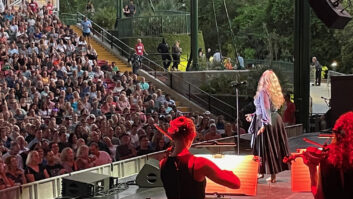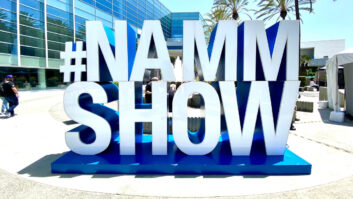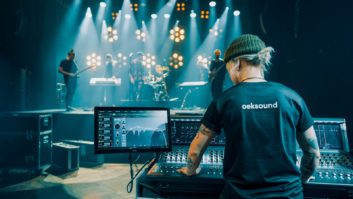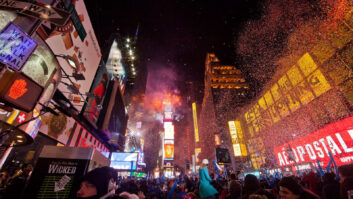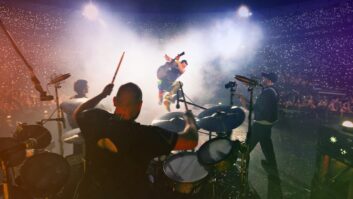When Natalie Merchant decided to end her 13-month Ophelia tour with a week on Broadway at the Neil Simon Theater, it seemed a good opportunity to make a live recording. After all, the tour was a career peak for the appealing pop singer, and it showcased songs from her entire career, as well as some new treats. Befitting the prestigious venue, David Hewitt, whom Merchant’s sound man George Cowan describes as “the Godfather of remote recording,” was retained to track the dates. Hewitt is celebrating his 30th year in the audio business and has worked with hundreds of artists from every genre, as well as recording the Metropolitan Opera and just about every major televised awards program.
On a beautiful, cool early June evening, Hewitt’s Pennsylvania-based Silver Studio was parked outside of the venerable Broadway house tracking one of Merchant’s nightly soundchecks two hours before a mid-week show. Inside, Merchant and her band were working through a note-for-note recitation of David Bowie’s “Space Oddity,” as well as Merchant’ own “Beloved Wife,” to an empty andbriskly air-conditioned house. Cowan looked over the board and compared notes with Hewitt over the intercom.
Cowan is well-suited to integrating the role of FOH man with that of de facto live recording producer. Until the beginning of the yearlong tour he was primarily a studio engineer, having worked at Bearsville Studios in upstate New York for many years, rising to the rank of chief engineer. Prior to that he had toured as sound man for Todd Rundgren. He knew Merchant from the Bearsville studio and was tapped to help ramp up the sound for her first round of big Lilith Fair dates, and then ended up taking over the full road responsibilities
To make certain that reel changes didn’t stop the show, Hewitt had four machines sitting side-by-side in pairs in the machine room of the Silver Studio. The main recorders were twin Studer 820 24-track analog machines running in tandem at 15 ips with Dolby SR, backed up by two Studer D827 48-track digital recorders (set to run in sequence) as a general safety and to catch the overlap between analog reel changes.
Additionally, Hewitt’s four Sony PCM-800 modular multitracks were taking MIDI signals and the feeds from 13 audience mics, arranged to facilitate a surround mix.
Despite the plethora of digital tracks this was a decidedly analog date. “I was pleased when they chose analog because I’m an analog recordist at heart,” Hewitt explains. “These analog Studers have a wonderful sound-a warm bottom and silky top, which is just right for a female vocalist such as Natalie Merchant.”
Merchant sang into her standard Shure SM58 wireless microphone and a wired 58 at the piano position. Was this road-standard mic really the best choice for the costly tracking of these important live performances? “I talked to Natalie about using a different mic, but she really likes the wireless for mobility and she likes the sound of the 58,” Cowan explains. “I didn’t consider other wireless units; however I did suggest trying a Neumann KM150, a premium wired handheld we’ve used on some television shows and which sounds good with her voice. And the idea of using a wired mic came more from concern about interference with the RF signal from cellular phone use.”
Hewitt did use a Millennia HV3 preamp on Merchant’s vocals. “It is my personal favorite,” he notes, “because it has wonderful cleanliness and neutral sound and a lot of headroom with its high-voltage rails. It is wonderful for female vocals.” Tube-Tech CL-1B and LA-2A compressor/limiters were also run by Hewitt on both of Merchant’s vocal mics.
For the first show there was one big onstage glitch that forced Cowan to make a change-a MIDI-output acoustic piano was quickly replaced by a non-MIDI Hamburg Steinway 7-foot grand. “We wanted to record MIDI to the sequencer just because we could, and to allow easy fixes of the occasional flubbed note without needing to bring in the artist,” Cowan explains. “But Natalie wasn’t comfortable with the feel and the sound of the MIDI piano. However, she loved the Hamburg Steinway we substituted right after the first show, and we got beautiful results with two Micro-Tech Gefell UMT-70S mics from Dave Hewitt’s truck.”
Other changes onstage included isolating the Leslie and bass amp cabinets behind Plexiglas and packing blankets near the back of the stage. “We got some pretty good isolation that way. We thought about putting the drums behind Plexiglas but decided to forego it for the sake of the organic feel Natalie was after,” Cowan says. “She did not want her live record to sound like it was made in the studio. We also passed on the Plexiglas for the band’s comfort.”
Almost no mic changes were made onstage from Merchant’s touring arsenal, with the exception of putting a Beyer M160 ribbon mic on the saxophone, a Sony C-48 on the bass cabinet and the two Micro-Tech Gefells on the piano. MIDI data was also taken from the string synthesizer “for sweetening purposes, so we could fatten up the strings easily in post if we wanted to,” says Cowan. Drum triggers were also recorded via transducers on the trap drummer’s two snares and toms. “We wanted these to control the gates; we could’ve used them to open samples, but we’re not a techno act. And the drums sounded just fine as they were,” Cowan says. The drum triggers were tracked to the PCM-800s along with the audience reactions.
Hewitt ended up with 69 inputs coming into his truck. A dozen of those were audience mic feeds, including a SoundField four-way field microphone that was suspended from a boom just in front of the balcony lip. The plethora of audience mics were there to accommodate surround mixing as the recordings are expected to end up on DVD, as well as CD and VHS. (The penultimate Broadway performance was also lavishly filmed with six 35mm motion picture cameras.)
“Natalie has an intimate act that requires audience interaction, and so we went to great pains with the audience and ambience mics, so those aspects will be as integral a part of the recording as they were of the performances,” Hewitt says.
In addition to the SoundField (which was feeding from all four capsules so that the SoundField decoder could be used for steering the image in post), other audience mics included two AKG 460s with CK Short Shot capsules on stage right and left (which were fed to the band’s in-ear monitors, so they could sense the audience’s response), a Shure SM91 at center, Audio-Technica 4073s onstage, Sony 535s hung in the balcony and Audio-Technica 4073s pointing up toward the balcony. The audience mic signals were mixed to a Studer 961 24-track “sidecar” console in the truck.
“The SoundField gave a good ambient picture of the soundstage in the hall, and it was far enough away from the audience to not be overpowered by applause,” Hewitt explains. “This is a bit more than average coverage for the audience and ambience, especially using all four capsules of the SoundField, but I think it is a good idea, especially when it will be going to a 5.1 surround mix,” says Hewitt.
Hewitt also used a variety of compressors on the band, with four vintage UREI LA-3As on all background vocals, a Drawmer 1960 stereo compressor on acoustic guitar and mandolin, Summit DCL 200 stereo compressor on bass and Empirical Labs Distressor compressors on the kick and snares.
Hewitt’s board is a Neve VRM 48×48 with Flying Faders and recall, which he chose for his truck in large part because of its solid construction. “It is the best-sounding, most robust board I could find. I don’t want to talk about the other consoles I’ve used that could not handle the traveling!” The Neve also has “nicesounding preamps, and every channel has high-quality compressors and noise gates, which is useful for the monitor side as well. They had a wonderful-sounding Wurlitzer organ onstage, but it was noisy. We weren’t, of course, taking the chance of gating it to tape, but the gates cleaned up the monitor mix so I didn’t have to sit and listen to that noise for five shows and numerous soundchecks.”
The truck is fitted with custom-made KRK 15A3 soffitt-mounted monitors with 15-inch woofers, 7-inch mids and 1-inch inverted dome tweeters. “I use the big speakers for detail and bottom end. When I mix I use the smaller KRK V8s,” Hewitt explains. The crossovers are Bryston 10Bs and the monitor EQ is a Sigtech AEC-1000 Digital Time Delay. Power comes from two Bryston 4B amplifiers for the woofers and two Bryston 3Bs for the mids and tweeters.
The dates were captured on BASF tape on the analog machines and Quantegy on the digital. “We normally use Quantegy, but Natalie likes the BASF tape she uses in the studio,” Hewitt says. “A great thing about the two low-hour, 10-year-old Studer A820 analog machines is the ease with which you can use different tapes, thanks to their computer-controlled alignments and bias settings. They’re a marvel for this type of work because it is such a pain to keep machines aligned on the road.”
The gig was a pleasure for Hewitt. “Natalie’s crew are all high-level professionals; George Cowan had everything mapped out well in advance,” notes Hewitt. “We often get called in at the last minute on some crazy tours and TV shows that are not necessarily that well-organized artistically and logistically, so this was wonderful. The shows were a treat for us because Natalie is just the right kind of performer for this intimate theater setting. She is so relaxed with her audience, and the music flows so freely. She is a unique artist.” And the proof is on the new CD, Live in Concert, released in November on Elektra Records.
